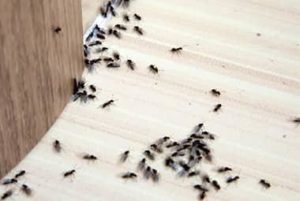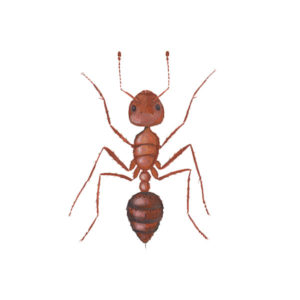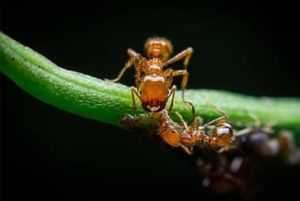Since we’ve already started a mini-series about ants (including odorous house ants and fire ants), I thought we might round off our discussion of one of East Tennessee’s most troublesome pest families with an introduction to one more common species. Today, we’ll have a look at carpenter ants and the trouble that they can cause when they invade homes or businesses.
As you can imagine based on their name, carpenter ants tunnel through wood to build their colonies (much like carpenter bees). Unlike termites, carpenter ants do not eat the wood that they destroy. They grind it into sawdust while they’re excavating and push the dust out into the open with the rest of their waste. Therefore, if you find piles of sawdust near your home (particularly if they’re inside), you should suspect carpenter ants first thing. In almost every case of carpenter ant invasion, excess moisture is present. The moisture softens the wood, making it much easier to remove than dry wood. Quite often, we find this species of ant near leaks around bathtubs or by leaks at exterior doors and windows. The presence of these ants could alert homeowners to the possibility of water-related problems.
Carpenter ants are nocturnal, so they are most active at night; this means that you may not encounter them in your home until they’ve already built up a substantial colony. If you do encounter carpenter ants in your home or business in an area ranging from Lenoir City to Knoxville to Sevierville, they are most likely to look like the one pictured here. The most common species in our area is the black carpenter ant. They are solid black, and each colony contains members of three different sizes. The smaller ants are more likely to stay near the nest and care for the young while the larger ants (which can be quite large) are more likely to be out foraging for food.
So, what are carpenter ants likely to be up to inside your home? Well, they’ll be doing exactly what every other bug does: looking for food, shelter, and water. Black carpenter ants can invade homes in order to set up a primary colony in wooden siding or in the wood frame inside your walls. These pesky critters can do some serious structural damage if they’re left untreated for any amount of time. However, it’s just as likely that their primary colony is outside in a stump somewhere and they are only using your house as a grocery store and nursery.
Carpenter ant eggs require a very moist environment while their later life cycles are more comfortable in a slightly dryer atmosphere. Because of that, these little explorers will often set up a secondary colony someplace out of the elements where they can tend their toddler-aged ants. In that case, you may have a nest without the telltale carpenter ant sawdust piles. They could be exploiting a hollow void in your house for their secondary colony. This could be a wall void (which is very inconvenient) or something much simpler like an infrequently-opened drawer or a long-untouched box.
The thing to remember is that carpenter ants like to follow well-established trails and prefer “roadways” when they can get them. You are most likely to see them walking along a wall, around your cabinets, or beside your garden hose outside. You can use this tendency against them and follow them all the way back to their nest. Once you follow them to the secondary nest inside your building, you can remove it and will be well on your way to eliminating your problem. Bear in mind that, unlike many ants, carpenter ants send only a small percentage (usually less than 10%) of their colony members out to forage at a time. If you are only killing the ants that you find eating the sugary juice spill in the kitchen, you will continue to have carpenter ant problems.
The pest control industry views ants as one of the hardest pests to control, and, let’s face it, plenty of people find it creepy to have so many little insects running around the house. If ant control is simply not your forte or not something you can fit into your schedule, we at Russell’s Pest Control would be happy to offer a helping hand. As always, you can give us a call or contact us online.
Carpenter Ants: The Busy Builders in Knoxville TN
Serving East Tennessee since 1971


